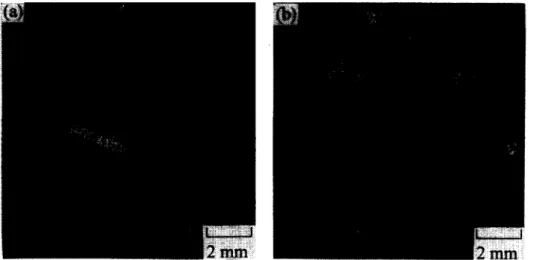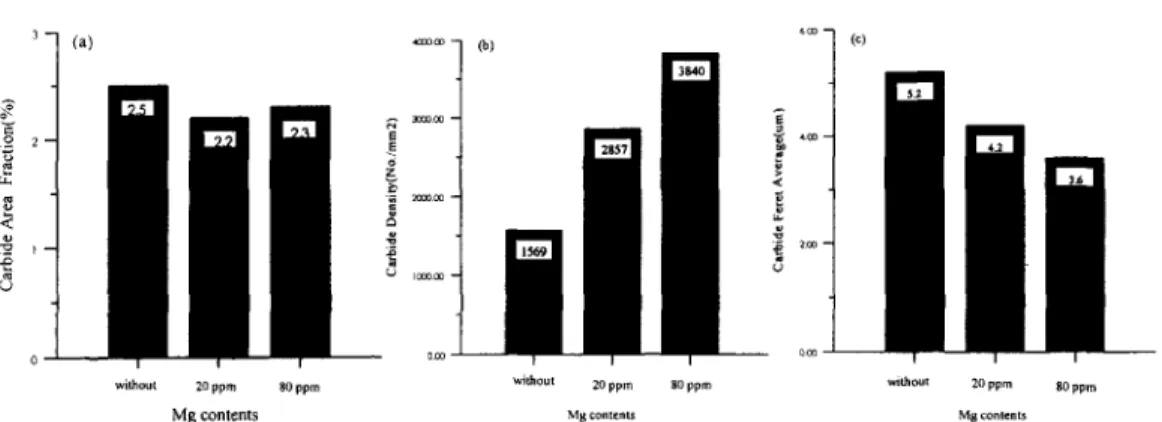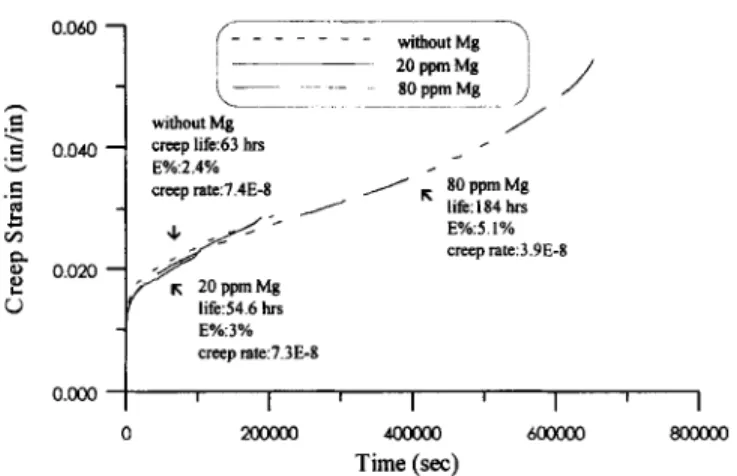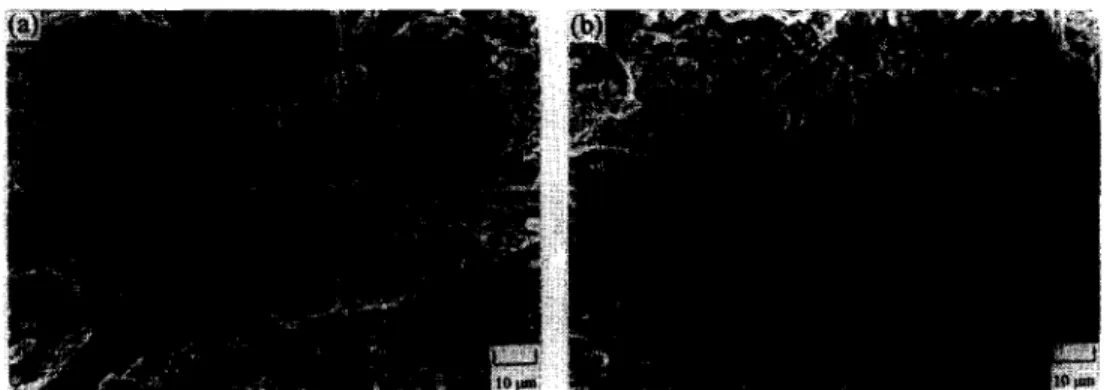PI1 S1359-6462(97)00444-Z
1359.6462/98 $19.00 + .OO
THIE INFLUENCE OF MAGNESIUM ON CARBIDE
CHARACTERISTICS AND CREEP BEHAVIOR OF THE
MAR-M247 SUPERALLOY
H.Y. Bor, C.G. Chao and C.Y. Ma*
Institute of Materials Science & Engineering, National Chiao-Tung University, Taiwan 30050, R.0.C
*Materials R & D Center, Chung-Shan Institute of Science and Technology, Taiwan 32536, R.O.C.
(Received April 3, 1997) (Accepted October 7, 1997 )
Introduction
Mar-M247, a typical cast Ni-base superalloy containing more than 60 vol.% -y’, has been widely
employed in fabricating advanced turbine blades and rotating parts in aerospace industry during the past two decades. Th.e merits of this alloy comprise excellent creep and good oxidation resistance at elevated
temperatures as the result of optimal alloy design [l-2]. However, Mar-M247, according to Engine
Materials Specification(EMS)-55447 and some previous studies [3-41, remains brittle at elevated
temperatures during creep and tensile tests even though considerable efforts were made in late 1970 by adding Hf to optimize microstructure, in particular y-y’ eutectic and grain boundary (GB) carbide. In all, the reasons leading to high temperature brittleness in Mar-M247 can be attributed to GB intrinsic behavior, coarse or large script carbides, harmful phases(such as Laves, o and p), abnormal grain size and defects existed during casting.
In recent investigations, it has been shown that the microaddition of Mg in wrought superalloys significantly enhances stress rupture life, ductility and fatigue endurance at elevated temperatures [5-181. These improvements are mainly associated with carbide refinement arising from segregation of
Mg to GB and carbide/matrix interface [ 10,12,14,15,17]. Although, some studies related to Mg
segregation phenomenon have been carried out [10,12,19,21], the true mechanisms are not fully
understood. Furthermore, little work has been reported [19-211 in introducing Mg as a microalloying
element in cast superalloys which are normally poor in ductility and toughness at both room and
elevated temperatures. On this basis, Mar-M247 superalloy was chosen for the first time in this work
for studying the influence of Mg microaddition on high temperature properties. The objectives of
present study were to determine the microstrnctural characteristics and to investigate the creep behavior of Mar-M247 superalloy due to the microaddition of Mg, particularly in ductility. In addition, some
available mechanisms associated with the microstructure change and property enhancement were
discussed in this paper.
330 CREEP CHARACTERISTICS Vol. 38. No. 2
TABLE I
Chemical Composition (wt.%) of Mar-M247 Superalloy Analyzed by XRF for Major Elements and Glow Discharge Mass Spectrometer (GDMS) for Mg and Trace Elements
Alloys Co Cr MO W Ta Ti Al Hf Zr Ni C S P Mg A 10.1 8.32 0.69 9.91 3.16 1 .oo 5.56 1.51 0.045 bal. 0.153 0.0003 0.0003 0.0008 B 10.1 8.20 0.71 9.86 3.17 1.04 5.69 1.37 0.040 bal. 0.149 0.0002 0.0003 0.002 C 10.1 8.14 0.72 9.74 3.00 0.97 5.47 1.29 0.040 bal. 0.156 0.0003 0.0003 0.008
ExDerimental
The materials used in this study were melted by vacuum induction melting (VIM) at Chung Shan Institute of Science and Technology in Taiwan, followed by remelted in a vacuum furnace and cast into
test bars. The pouring and mold temperatures were 1480°C and lOOO”C, respectively. Three heats of
Mar-M247 superalloy both without Mg(alloy A) and with Mg(alloy B and C) were prepared. The
compositions of the parent alloys used in this investigation are given in Table I. The Mg content in alloy A was measured to be 8 ppm from raw materials. After casting, all test bars were subjected to heat treatment; that was 1185W2 hrs for solution treatment and then 871W20 hrs for aging. Microstruc-
tural observations were made by optical microscopy (OM) and scanning electron microscopy (SEM).
The density, area fraction and Feret average (i.e. the long axis size) of various carbide particles in
as-cast and heat-treated samples were measured using a LECO 2000 image analyzer. Thirty optical
microscope adjoining fields from the polished samples were taken at a magnification of 500 times for each specimen. High temperature tensile tests were carried out at 899°C using an Instron mechanical
testing machine. The creep test was conducted under 76OW735 MPa using SATEC M3 creep testers.
The gauge size of test bars was 6.3 mm in diameter and 26 mm in length. The fracture surfaces were examined in a Joel-6400 SEM equipped with EDS for microanalysis.
Results
The microstructure of Mar-M247 superalloy (alloy A) after normal heat treatment contains cuboidal y’ phase, ‘y-y’ eutectic, Chinese script MC and grain boundary M,,C, carbides, as shown in Fig. 1. Among them the area fraction of carbide was around 2.4%. The results of microstructure analysis show that Mg additions have no influence on grain size (Fig. 2). It remains 2-3 mm under the casting condition
Figure 1. Microstructure of Mar-M247 superalloy (alloy A) subjected to 1185YY2 hrs for solution treatment followed by 871”C/20 hrs for precipitation.
Figure: 2. Grain sizes of Mar-M247 superalloy (a)without and (b)with 80 ppm Mg microaddition.
mentioned above. However, it is obvious in Fig. 3 that 80 ppm Mg addition in Mar-M247 decreases not
only interdendrj.tic precipitates of carbide amount, but also changes its morphology from script
(plate-like) to globular and discrete form. In other words, the percentage of script-like carbides can be reduced due to optimal addition of Mg. The results of image analysis indicate that the area fraction of carbide particles is unaffected by microaddition of Mg (Fig. 4(a)). However, the carbide particle density clearly increases with increasing Mg contents(Fig. 4(b)). These results depict that optimal addition of Mg makes carbides finer and spheroidal, including both MC in matrix and M,,C, at GB. Feret average measurement illustrates the same outcome of carbide refinement, since the values are declined from 5.2 pm (without Mg) down to 3.6 pm (80 ppm Mg), as shown in Fig.4(c).
The tensile properties of Mar-M247 with various Mg contents tested at 899°C are listed in Table II. Obviously, a drastic improvement in ductility brings about as the result of microaddition of 80 ppm Mg. The ultimate tensile strength remains unaffected as Mg goes from 0 to 80 ppm, although there is around
10 reduction in yield strength. According to creep test results, Mg can remarkably enhance the
76OW735 MPa creep life and ductility as well, as indicated in Fig. 5. The alloy with 80 ppm Mg exhibits three different stages during creep, while the alloys without Mg or only with little Mg addition (20 ppm) have no tertiary stage of creep. Obviously, the creep lives increase with increasing Mg
Figure 3. Carbide morphology and distribution of Mar-M247 superalloy (a) without, (b) with 20 ppm and (c) with 80 ppm Mg addition.
332 CREEP CHARACTERISTICS Vol. 38. No. 2
Wh”, 20 &T-m 80 m wlhut 20 mm 80 m wtulo”t 20 m
Wpm
Mg contents Mg contents Mg contents
Figure 4. Image analysis results of (a) carbide area fraction (b) carbide density and (c) carbide Feret average in Mar-M247 superalloys. Feret Average is defined as the long axis size of carbide particles.
contents up to 80 ppm. The same result is also found in creep elongation. In Table III, creep elongation
of some specimens without Mg addition is even lower than the EMS-55447 requirement of 2% when
creep-tested under 76OYY735 MPa. For the specimens with 80 ppm Mg, however, elongation is
effectively improved to 5.1%. Furthermore, the creep lives are also prolonged to at least 3 times in comparison with that of specimens without Mg addition. As to the steady state creep rate, it tends to be unaffected by Mg addition and remains approximately similar( 10-8sp ‘), however, the alloy with 80 ppm Mg still has a lower creep rate.
On the basis of fractographic observation from the specimens tested under 76OW735 MPa, the
fracture mode of all Mar-M247 specimens appears to be mixed, involving intergranular and trans-
granular in general. However, the phenomenon of intergranular fracture in alloy A is more remarkable than that of Mg additions alloys. Further, alloy A exhibits significantly cracked evidences of script carbide decohesion within grain interior (Fig.6(a)), showing that the occurrence of fracture can be formed at script carbide/matrix interface or GB carbides. In contrast, the phenomena of script carbide decohesion and interdentritic brittleness are drastically reduced in 80 ppm Mg alloy (Fig.6(b)). The fine dimples existed on fracture surface and the evidences of fine carbide decohesion reflect the improve-
ment of high temperature brittleness in Mg-containing Mar-M247 superalloy.
Discussion
Conventional cast nickel-base superalloy are mainly strengthened through carbide precipitation at GB and y’ phase in matrix. Discrete GB carbides are generally considered beneficial since they inhibit GB
TABLE 11
Tensile Test Results of Various Mg Contents in Mar-M247 at 899 “C Mg Contents Y.S. (MPa) U.T.S. (MW Elongation (%) EMS-55447 without Mg 20 wm Mg 80 ppm Mg 420 700 4.0 676 794 4.7 653 812 5.1 617 803 14.0
without h4g creep life:63 hrs E%:2.4% weep ratc7.4E-8 / , / ; ~OtvmMg Me:184 tm E%:5 I% creep rate:3.9E-8 lifc54.6 hrs E%:3% ereeg rate:7_3E-8
0 m 4ooooo dooooo eooooo
Time (see)
Figure 5. Creep curves of various Mg contents in Mar-M247 tested under 76OW735 MPa.
sliding and retard the onset of creep cavitation and rupture. Hence, carbide morphology and distribution play a crucial role in determining the creep behavior of superalloys. According to the present results,
microaddition of 80 ppm Mg in Mar-M247 superalloy can remarkably refine and spheroidize carbides
both within gram interior and at GB. These mainly result in the increase of high temperature ductility
and the improvement of creep life and ductility. The fractograghic observation also proves these
relevant evidences. As has been pointed out previously, from view points of alloy design, performance
and applications, Mar-M247 superalloy exhibits a high temperature brittleness under 76OW735 MPa.
This finding might give rise to more extensive usage in aerospace industries or some relevant
applications.
Regarding the mechanisms of Mg microaddition in superalloy causing the ductility enhancement, Ke [23] and Chemyak [22] indicated that Mg could purify GB through binding with detrimental elements, such as S, P, 0, etc. In this work, however, the contents of S, P and other trace elements determined were far below 5 ppm. It means that the improvement of high temperature ductility in Mar-M247 might
not be directly related to this mechanism. In terms of energy concept, some researchers [23-271
proposed that Mg microaddition would segregate to GB and carbide/matrix interface, leading to the
interfacial energy reduction between carbides and matrix. Since this effect could increase cohesion of carbide/matrix interface, retard creep crack initiation and propagation and prolong the total creep life and elongation. Some direct results [ 10,12,16,19,21] about Mg segregation have been reported by using AES and HRTEIM, which are associated with the refinement and spheroidization of carbides. Based on the present investigation, the improvement of high temperature ductility in this system is related to the carbide refinement. Detailed studies with respect to the interfacial characteristics with the methods of
TABLE III
Creep Behavior of Various Mg Contents in Mat-M247 Tested Under 760 “C/735 MPa
Mg Contents EMS-55447 without Mg 20 ppm Mg 80 ppm Mg Creep life (W >23 26-63 55-87 136-183 Elongation (%) >2 1.9-2.4 3.0-4.2 3.5-5.1 Creep Rate W’) - 7.4 x 1om8 7.3 x 1o-8 3.9 x 1o-8
Figure 6. Fractographic observation of (a) without Mg and (b) with Mg in Mar-M247 after creep testing of 76O”C/735 MPa.
structural identification and chemistry determination are worth being performed to account for these phenomena.
Finally, it should be emphasized that increase of creep life and ductility as the result of Mg
microaddition in Mar-M247 might depend on the operation environments. In other words, under
different creep conditions, the fractures behaviors will be controlled and determined by various
deformation mechanisms. In addition, interfacial characteristics might behave in different ways and this will, of course, lead to various performance of alloys. Furthermore, the optimal amount of Mg in
Mar-M247 and the effect of Mg over-addition remains unclear. More relevant work is needed to be
done in the future.
Conclusions
According to the present results, it can be concluded that microaddition of Mg in Mar-M247 can change
script carbide morphology and refine carbides significantly. Mg increases 899°C tensile ductility
drastically when Mg contents in Mar-M247 superalloy reach 80 ppm. Also, microaddition of Mg can
apparently enhance creep life and elongation of Mar-M247 superalloy under the test condition of
76O”C/735 MPa. The steady state creep rate of Mar-M247, however, remains unaffected. Fractographic observation shows that the cracking evidences along script carbides are reduced in Mg-containing alloy. This improvement is strongly related to the enhancement of high temperature ductility.
Acknowledgments
The authors would like to thank Dr. C. C. Yang, Dr. J. Y. Wang, Mr. S. C. Yang and Mr. C. M. Chen for their help in mechanical property evaluation. The equipment support of processing from Dr. Y.L. Lin and Mr. J.S. Chen are thankfully acknowledged.
References
1. J. E. Doherty, B. H. Kear, and A. F. Giamei, Journal of Metals. Nov., 59 (1971). 2. D. N. Duhi and C. P. Sullivan, Journal of Metals. Jul., 38 (1971).
3. Engine Materials Specification 55447, Castings, Investment, MAR-M247, Allied-Signal Aerospace Company (I 988). 4. M. Kaufman, in Proceedings of Superalloys 1984, ed. M. Cell, et al., p. 43, AIME (1984).
5. .I. Schramm, US Patent No. 3512963, May 19 (1970).
7. 8. 9. 10. 11. 12. 13. 14. 15. 16. 17. 18. 19. 20.
21. Q. Zhu, D. Wang, H. Ge, and G. Chen, Acta Metallurgica Sinica. 3, Al85 (1989). 22. G. S. Chyemyak, Metall. (Metalli.) SSSR. No. 1, 144 (1973).
23. D. Ke, Thesis for master’s degree, Central Iron and Steel Research Institute, Beijing, China (1981). 24. D. Ke and Z. Y. Zhong, Acta Metallurgica Sinica. 19, A377 (1983).
25. P. Ma, et al., Acta Metallurgica Sinica. 19, A377 (1983). 26. P. Ma, et al., Acta Metallurgica Sinica. 23, Al95 (1987).
27. D. Ke and Z. Y. Zhong, Central Iron and Steel Research Institute Technical Bulletin. 73, 3 (1983).
D. R. Muzyka. et al., Process for Making Nickel Base Precipitation Hardenable Alloys, US Patent No. 3575734, April 20 (1971).
J. M. Moyer, in Proceedings of Superalloys 1984, ed. M. Cell, et al., p. 443, AIME (1984). D. A. Ford, Met. Technol., 11, 438 (1984).
G. L. Chen, D. Wang, Z. C. Xu, J. Fu, K. Q. Ni, X. S. Xie, X. Jin, E. P. Chen, and T. F. Yu, in Proceedings of Superalloys 1984, ed. M. Cell, et al., p. 611, AIME (1984).
K. D. Ke and Z. Y. Zhong, Acta Metall. Sin. 5, A377 (1983). P. Ma and J. Zhu, Metallography, 19, 115 (1986).
Z. Xu, B. Qu, X. Xie, S. Zhou, and X. F. Cheng, Journal of Beijing University of Iron and Steel Technology, 9(4) (1987). P. Ma, Y. Yuan, and Z. Y. Zhong, in Proceedings of Superalloys 1988, ed. S. Reichman, et al., p. 625, AIME (1988). X.H. Xie, Z. H. Xu, B. Qu. and G. L. Chen, in Proceedings of Superalloys 1988, ed. S. Reichman, et al., p. 635, AIME (1988).
J. Zhu, Z. Y. Cheng, and H. Q. Ye, Scripta Metall. 23, 1537 (1989).
G. L. Chen, T. H. Zhang, and W. Y. Yang, High Temperature Technology. 6(3) (1988). Y. Q. Li and Y. H. Gong, Journal of Materials Science. 27, 6641 (1992).
H. L. Ge, W. V. Youdelis, G. L. Chen, and Q. Zhu, Materials Science and Technology. 5, 985 (1989).
G. Chen, Q. Zhu, D. Wang, and X. Xie, in Superalloy 718, ed. E. A. Loria, p. 545, The Minerals, Metals Materials Society (1989).




